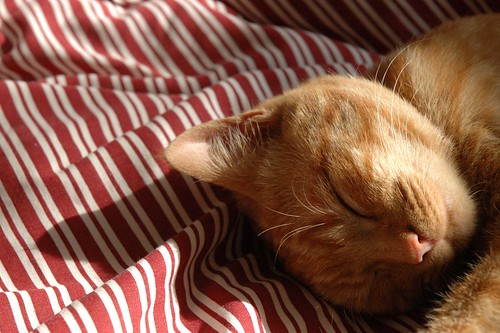I walked into her room. She was lying in her bed, her silver hair in one long, beautiful braid down the side of her face, her eyes closed, arms crossed over her chest, breathing quietly. She had one leg up, bent under the blanket. At the foot of the bed her cat was curled in a ball. The walls were covered in cat pictures, cat sayings, cat drawings: a feline-lover’s dream. She was even wearing cat pajamas.
I came to the side of her bed, to whisper hello and listen to her lungs. Instead I burst into tears and could not stop. In 25 years of practicing medicine I have never done this. As I wept, our recreation director came in to give me a hug. And then she told me not to cry, because Sandy was not suffering any more.
Sandy has early-onset Alzheimer’s disease. She and her husband Gary led a life together full of passion for the outdoors and for animals (sheep dogs AND cats). Gary cared for her at home as long as he could. But Sandy started having severe neuro-psychiatric symptoms and Gary could not be a non-stop caregiver watching her every step. After she moved into our memory care facility, Gary was frequently present and continued to be the sun she always sought. He brought her cat to live with her (and us) and for a time she enjoyed the cat and the garden. She had, despite her difficult behaviors, a sweet demeanor and the staff quickly bonded with her.
So as she deteriorated and suffered more and more, we all had our hearts break. She became always lost and afraid. She started falling and being unsafe. The aides struggled to work with her because nothing they could do would make her feel secure, and at times they felt they failed her. Gary was the only one who could calm her.
Medically, I tried everything. I met with our fantastic unit director and Gary repeatedly to discuss environmental adjustments. I constantly titrated medications. I had long discussions with Gary about referrals to inpatient geriatric psychiatry wards and we agonized together about the burden of moving her against the potential for some improvement. I felt I was letting Sandy down. Was I hurting her in some way with my choices of medications? Was she getting worse because of the disease? Or because of me?
One week earlier, I joined our local Alzheimer’s Association’s annual Walk. Gary and I walked together. Sandy couldn’t be with us on this beautiful, early fall day. We knew she would have enjoyed it, as she had in the past. I was honored to walk with Gary. He carries such a burden and he carries it so well.
Sandy died the day after my visit. She died peacefully in her bed with Gary and her beloved cat.
I think I shed tears not only for my inability to conquer her demons and allow her peace, but I also felt a deep gratitude for being able to help her life end without enduring multiple hospitalizations, intrusive procedures and innumerable health care providers who didn’t know her background, none of which would have made a difference, ultimately. I believe the depth of peace I was witnessing in her final hours was overwhelming.
I can’t cure Alzheimer’s and sometimes it feels like this disease torments me. But I surely can rage and join my patients, families and colleagues in making sure the disease does not rob my patients of their final days in peace.
by: Carole Baraldi
Acknowledgement: We would like to thank Sandy’s husband for giving permission to share this story.




